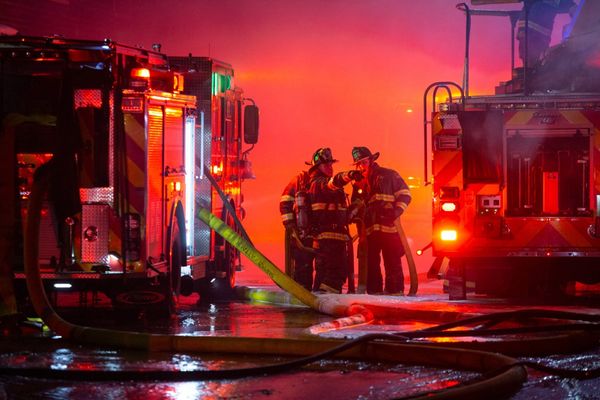
Hanna Franzén
I had been photographing a press conference at the Swedish parliament in November last year. The wind was cold as I came out and there were dark clouds in the sky, but despite this a dozen people, adults and children, had gathered to demonstrate outside, Greta Thunberg among them. We talked a little about what she thought about the future, I took some pictures, and walked away. When I looked back at her a few seconds later, she was being interviewed by another journalist. I remember thinking, “This is the beginning of something big.”
Greta’s message is extremely important. She wants to take care of the Earth and the resources that are left to us. I am very proud of my own efforts in spreading her message – my picture has been in an exhibition in Canada, on a book cover, made into postcards, stickers and published all over the world. Girl power. As told to Imogen Tilden

Ami Vitale
With only about 5,500 black rhinos left in the world, each one is so precious that conservationists, such as those at Lewa wildlife conservancy, have to work hard to ensure their survival. Since the conservancy’s founding in 1983, Lewa’s rhino population has grown from 15 to 169. Yet if poaching continues at its current level, rhinos and elephants will be functionally extinct in our lifetimes.
We often forget, however, that the best protectors of landscapes are local communities – who often live on the frontlines of poaching wars. These Samburu warriors had never seen a rhino before; some had never even seen a photo of one. They had visited Lewa to learn about conservation.
Without rhinos, elephants and other wildlife we suffer more than loss of ecosystem health. We suffer a loss of imagination, a loss of wonder, a loss of beautiful possibilities. When we see ourselves as part of nature, we understand that saving nature is really about saving ourselves. As told to Imogen Tilden

Ivan Kashinsky
Sandy is 22 and lives in the heart of gang territory in East Los Angeles. There’s a bullet hole in her front window, and there are helicopters so often overhead they call them ghetto birds. At the time of this photo, October 2017, her brother Edgar was in jail, and her other brother, Marco, had been killed in gang violence the previous year.
Kids are introduced to a gang lifestyle from a very young age, but Sandy refused to be sucked in by the cycle of drugs and violence. She graduated from high school and at the time was studying in college alongside volunteering at a local boxing club and helping to raise Edgar’s kids. She’s a miracle! Such a positive force, a symbol of hope.
She and her family visit Marco’s grave every Sunday; that’s her mum and her niece also in the picture. The whole family hang out there for an hour or two each week, they picnic, the kids play and they remember the good times they had with Marco. As told to Imogen Tilden

Moises Saman
It was early morning, maybe 6am. I was in Lesbos, the Greek island that marks the end of many refugees’ journeys to Europe. But it also marks the beginning of a whole new journey and set of difficulties.
The boats usually arrived under the cover of darkness. During the days you could see them slowly approaching, and we would track their progress and try to calculate where they would come in.
The minute the boats landed, most passengers would set off up the beach towards the reception centre, but some would pause briefly to unpack their cellphones or dry off a little, and that would give me a chance to talk to them. These men had started this leg of their voyage in Turkey, but they were mostly from Afghanistan originally.
I have covered refugee crises all over the world for the past decade and I continue to be struck by the desperation that drives people to leave everything they own and set out into the unknown on extremely dangerous journeys. When crowded and barely seaworthy boats actually make it to Europe, like this one had, you see such joy and hope on their faces.
For one brief moment, these young men knew that they had taken charge of their lives and they felt empowered, and hopeful that they had a future. As told to Imogen Tilden

Shahidul Alam
I was doing a story on HIV and Aids in Bangladesh when I met Hazera Beagum. This was 1996, when she was a sex worker. We became friends. Later, around 2008, I found out that she had set up this orphanage on the edge of Dhaka for children like her.
It’s a very special place. She doesn’t take a salary. I asked how she survives and she said: “We share the food that we have and there is a roof over our heads. Thirty-five kids call me mum … what more can I ask for?”
I spent one night with them. The kids were all singing and dancing. I was sitting down talking to one of the other kids when I saw this girl doing the twirl … I didn’t have the time to get my camera, but luckily I had a little Panasonic with me so I was able to record the moment.
Hazera is a very loving mother, but she’s also strict – she makes sure the kids do their homework, pray and clean up. They all adore her. And they have ambition – the girl in the photo wants to be a model when she grows up.
Hazera has had a very, very difficult life – she was abused, gang-raped and forced into pickpocketing and later, prostitution. But rather than be bitter about it, she has turned her life around to create dreams for other people. As told to Tim Jonze

Dominique Catton
The picture was taken in Yaoundé, the political capital of Cameroon. Cameroon shelters around 400,000 refugees, the vast majority from Nigeria and the Central African Republic.
I spent six months last year following two families who had fled from war in CAR more than a decade ago. They had chosen to live in the city in the hope that they would have a better chance of making a new life, but the reality is that refugees often find themselves exploited, vulnerable and paid far less than the legal wage. Merveille is eight and she’s throwing a ball in her family’s tiny backyard where she and her brothers play and where the family wash clothes, cook, and throw their garbage.
Her father had an accident at work and because he was unable to afford medical care he is now disabled and can only sit at home on the couch. Her mother works for less than $1 a day in a restaurant. I asked Merveille about her dreams. She told me she dreamed her mum would stop worrying, and that her father could go out of the house.
She wants to become a school teacher. During the months I spent with the family, no matter how difficult things were, the children were always playing and laughing. As long as kids can be kids there’s hope. These children are our future and we must trust in them and give them the opportunities they deserve.
This picture wants to show that there are hopes, dreams and poetry under the corrugated iron. As told to Imogen Tilden

Lucas Foglia
Singapore is an island city-state with a 100% urban population. There are hardly any wild green spaces left, but they’re trying to reintegrate them into the city. The Singapore Green Plan promotes conservation of the nation’s natural resources and the use of green technology to conserve the environment. The Park Royal on Pickering contains more than 15,000 sq metres of greenery, amounting to twice its land area.
I was staying at the hotel and asked if I could photograph the balcony gardens. I went up to the roof for a more complete view: to get this shot I had to lean out over the edge, holding a fire escape ladder. The morning rush hour was just beginning and the traffic was starting to build. Below me, a swimmer was doing laps in the balcony pool, and there was one exact moment when she was positioned in the middle so I could see the whole form of her body, and the colours of cars on the street and that of the plants matched up perfectly.
Green spaces improve both air quality and happiness. Plants absorb heat and make buildings cooler. Flooding risks during heavy rains are lowered, because soil absorbs water. They also allow other species to reside or migrate safely. Most countries have not yet made the reforms needed to curb climate change. But there are examples of green buildings all across the world, and schemes such as Singapore’s can make a difference. Hope is the fuel we need to fix the world. As told to Imogen Tilden

Olivia Harris
I’d been in Ireland shooting a series on the Repeal the Eighth campaign [on abortion rights] and I decided to look out for other ways in which women’s lives were restricted. I met Katie when I went to photograph her family on their farm in the Wicklow Mountains. She was one of six kids from a classically Irish family full of national pride. I remember she was very enthusiastic about being an altar server at a local church. She said that she wanted to be a priest when she was older, but that she’d never seen a woman giving mass on telly. I didn’t want to be the one to tell her that she couldn’t be a priest.
We went out to a field near her house full of buttercups. She was almost totally unaware of the fact she was being photographed, not self-conscious at all. That’s what’s hopeful to me about the image. I felt confident she would find other ways to achieve her life goals, even if the Catholic church won’t have her. As told to Tim Jonze

Ivor Prickett
I spent time in Mosul in early 2018, six months after the battle to retake it from Islamic State. The theme park on the banks of the river Tigris had been completely destroyed by heavy fighting. But only a matter of months later it was up and running again and families and young couples were visiting.
I remember the booming Iraqi pop music blaring out of the loudspeakers on this ride, the Crazy Dance, and finding it very poignant, especially to see women there, smiling, wearing colourful headscarves. Under Isis, women had been largely kept inside, but now they were able to move freely around the city again, attend the university, enjoy leisure time.
There’s a risk that when a part of the world is only seen through images of conflict and destruction people can get compassion fatigue. The way the news cycle works makes it difficult to stick around after the guns have fallen silent, but it’s so important to also see the aftermath of these terrible situations and seek out the more hopeful stories about returning to life.
You can’t whitewash over what’s happened – you are in the midst of people looking for or mourning their loved ones, but you need to find balance and show images people can relate to. These stories and pictures can be a form of catharsis for the people you’re portraying and the viewer as well. As told to Imogen Tilden







